Last updated: July 8, 2025
Why do blue roan horses captivate riders and breeders alike? Their striking, misty coats blend mystery with elegance, making them a standout in the equine world. A “blue roan” is simply a horse with a coat featuring a mix of black and white hairs, creating a stunning bluish-gray appearance—often with a darker, solid head and lower legs for a neat contrast—not a true “blue” horse as the name might suggest.
In this guide, you’ll explore the breeds that showcase this unique color, uncover the genetics behind it, learn how to identify blue roans, and discover care tips to maintain their beauty. We’ll also address common questions in our FAQs. Dive deeper into equine colors with our Horse Coat Colors: 12 Patterns & Pictures, explore genetics in the Equine Genetics Color Guide, and check out breed profiles like the Quarter Horse Breed Guide for more insights.
🐴 Blue Roan Horse Quick Facts
| Feature | Details |
|---|---|
| Color | Black base coat with evenly mixed white hairs; head/legs remain dark |
| Genetics | Dominant roan gene (Rn) on a black base; see UK Equine Genetics |
| Common Breeds | Quarter Horse, Paint, Mustang, Percheron, Tennessee Walker |
| Rarity | ~2% of registered Quarter Horses are blue roan (AQHA) |
| Care Needs | Standard grooming; extra attention to sun and skin health |
| Key Difference | Blue roans retain color for life; grays lighten over time |

What Is a Blue Roan Horse?
A blue roan horse has a black base coat evenly mixed with white hairs across its body, giving it a bluish-gray appearance. The head, mane, tail, and lower legs usually remain dark, creating a striking contrast. This pattern is caused by the dominant roan gene (Rn) and is seen in breeds like the Quarter Horse, Belgian Draft, and Paso Fino.
Unlike gray horses that lighten over time, blue roans keep their bold coloring for life. Their shimmering, steel-blue look makes them stand out in any setting, whether in a show ring or pasture.
Clarifying the “Blue” in Blue Roan
Despite the name, a blue roan horse is not genetically “blue.” The term refers solely to the visual perception of its coat. It’s crucial to distinguish blue roans from other similar-looking but genetically distinct colors:
- Not Gray: Gray horses are born with a solid color (like bay, black, or chestnut) and progressively lighten with age, eventually turning completely white or nearly white. A blue roan is born with its roan coloration and generally retains that pattern throughout its life, though its coat may appear darker in winter and lighter in summer.
- Not Grullo (or Blue Dun): A grullo (pronounced “groo-yo”) is a dun dilution of a black horse, typically featuring a smoky, mouse-gray body color with a distinct black dorsal stripe, primitive markings like leg barring, and a black mane and tail. Unlike a blue roan, a grullo does not have white hairs mixed throughout its coat; its color comes from a single diluted pigment. “Blue dun” is sometimes used interchangeably with grullo.
- Not a “True Blue”: There is no genetic “blue” pigment in horses. The “blue” in blue roan is purely descriptive of its unique visual effect.
Visualize this beauty with the image below, and use the comparison chart to distinguish blue roan from similar colors.

| Feature | Blue Roan | Gray | Grullo | Blue Dun |
|---|---|---|---|---|
| Genetic Basis | Black base + Roan gene (Rn) | Any base color + Gray gene (G) | Black base + Dun gene (D) | Black base + Dun gene (D) with modifiers |
| Appearance | Even mix of black & white hairs, bluish-gray body. Darker head/legs/mane/tail. | Born dark, lightens to white or dappled gray over time. | Smoky/mousey gray body. Black points, dorsal stripe, leg barring. | Bluish tint with dun characteristics, black points. |
| Age Progression | Color remains consistent. | Gets progressively lighter/whiter. | Color is consistent. | Color is consistent. |
| White Hairs | Intermixed evenly on body. | Accumulate over time, leading to lightening. | No white hairs mixed. | No white hairs mixed. |
| Primitive Markings | No | No | Yes (dorsal stripe, leg barring) | Yes (dorsal stripe, leg barring) |
The Genetics Behind the Blue Roan Coat
The blue roan’s striking coat is a fascinating example of equine genetics. It’s not just about one gene, but the interaction of two: the base coat color and the roan gene.
Base Coat Color: The Foundation
For a horse to be blue roan, it must have a black base coat. Genetically, this means the horse carries the black gene (E/E or E/e) at the Extension locus, which produces black pigment (eumelanin), and lacks the agouti gene (a/a), which would otherwise restrict black pigment to the points (mane, tail, and legs), as seen in bay horses. This black foundation is essential for the blue roan pattern to emerge.
The Roan Gene (Rn): Adding the White
The roan pattern is caused by the dominant roan gene, symbolized as Rn. This gene causes an even distribution of white hairs intermingled with the black hairs across the horse’s body, creating the signature bluish-gray effect. The head, lower legs, mane, and tail typically remain solid black, as the roan gene has less effect on these areas.
Recessive/Dominant Gene Interaction
The roan gene (Rn) is dominant, meaning a horse only needs to inherit one copy of the Rn allele to express the roan pattern:
- If a horse has the genotype Rn/Rn or Rn/rn, it will be roan.
- If a horse has the genotype rn/rn (inheriting a recessive rn allele from each parent), it will not be roan, retaining its base color (e.g., solid black).
When paired with a black base, Rn produces a blue roan; with a red base (e/e), it creates a red roan.

How the Roan Gene Interacts with Base Colors
The roan gene (Rn) dilutes a horse’s base color by interspersing white hairs throughout the coat. The final roan shade depends on the underlying coat color. Here’s how it works:
Base Color Table
| Base Color | Base Genotype | Roan Gene | Resulting Color | Genetic Interaction | Example Breeds |
|---|---|---|---|---|---|
| Black | E/e or E/E + a/a | Rn/rn | Blue Roan | White hairs over black base | Quarter Horse, Belgian |
| Bay | E/e or E/E + A/a or A/A | Rn/rn | Bay Roan (sometimes called Red Roan) | White hairs over bay base | Welsh Pony, Paso Fino |
| Chestnut | e/e | Rn/rn | Strawberry Roan | White hairs over chestnut base | Tennessee Walker, Australian Stock Horse |
| Buckskin | E/e + A/A + Cr/cr | Rn/rn | Buckskin Roan | White hairs over golden dun base | Mustang, Quarter Horse |
| Palomino | e/e + Cr/cr | Rn/rn | Palomino Roan | White hairs over golden base | Haflinger cross, American Quarter Horse |
Roan Inheritance: Punnett Square Scenarios
Roan is a dominant gene. A horse needs only one copy (Rn/rn) to display the roan pattern. Here’s how breeding outcomes work:
Scenario 1: One Roan Parent (Rn/rn) × One Non-Roan Parent (rn/rn)
| Rn | rn | |
|---|---|---|
| rn | Rn/rn (Roan) | rn/rn (Non-Roan) |
| rn | Rn/rn (Roan) | rn/rn (Non-Roan) |
- 50% chance of roan foals (Rn/rn)
- 50% chance of non-roan foals (rn/rn)
Scenario 2: Two Roan Parents (Rn/rn × Rn/rn)
| Rn | rn | |
|---|---|---|
| Rn | Rn/Rn (Homozygous Roan) | Rn/rn (Roan) |
| rn | Rn/rn (Roan) | rn/rn (Non-Roan) |
- 25% chance of a homozygous roan foal (Rn/Rn)
- 50% chance of a heterozygous roan foal (Rn/rn)
- 25% chance of a non-roan foal (rn/rn)
Key takeaway:
- Homozygous roans (Rn/Rn) are rare and will always produce roan offspring.
- Heterozygous roans (Rn/rn) have a 50% chance of passing the gene to their foals.
Horse Breeds That Commonly Produce Blue Roans
Blue roan horses are a rare and stunning sight, but certain breeds are more likely to produce this captivating coat color. Below is a curated list of horse breeds known for their blue roan variations, complete with key facts and visuals to help you explore these remarkable equines.
American Quarter Horse

Quarter Horses are a top breed for blue roans, prized for their versatility in ranch work and competitions. My son competes in roping events on a blue roan Quarter Horse and has done quite well! According to a 2006 report by the American Quarter Horse Association, only 2.27% of registered Quarter Horses were blue roan, making them highly sought-after. Learn more in our Quarter Horse Profile.
American Paint Horse
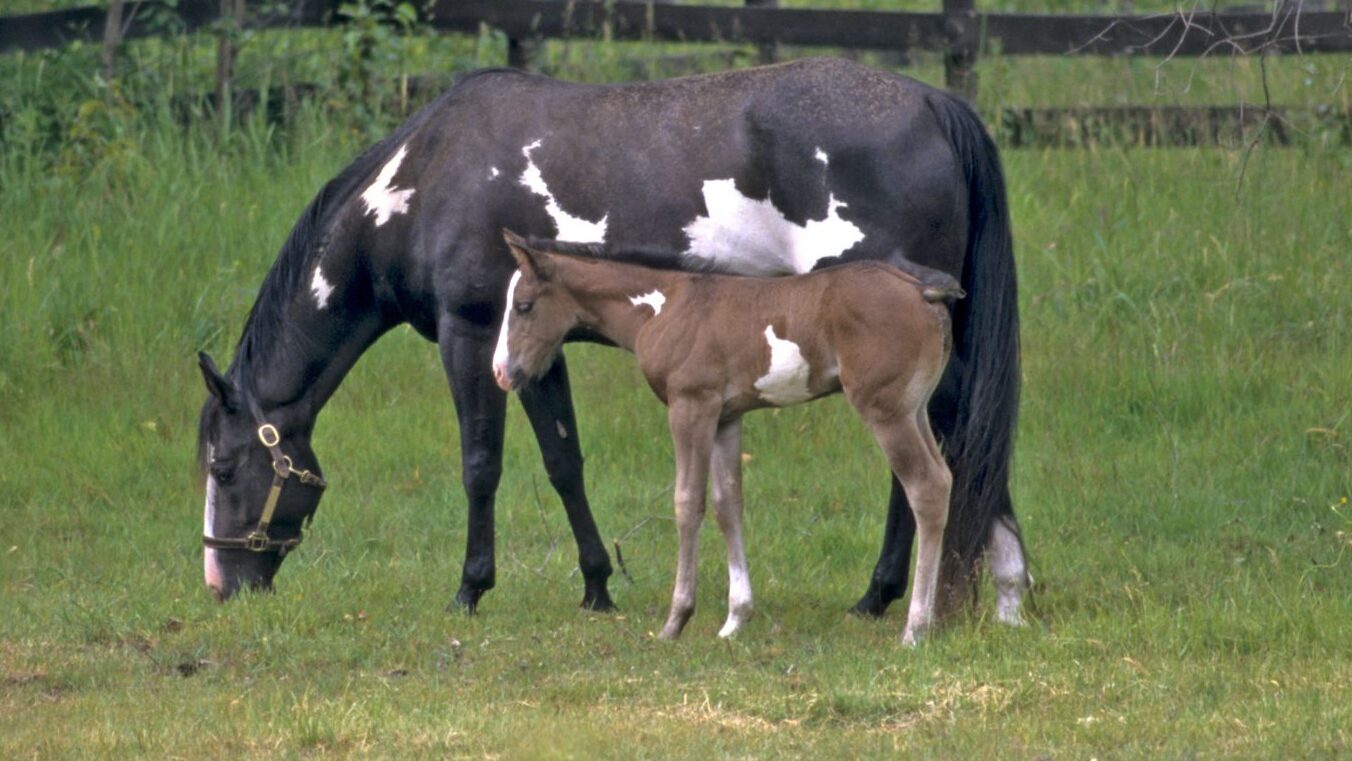
Paint Horses with blue roan coloring often combine this coat with unique patterns like tobiano or overo, making them true works of art. I recently saw a blue roan Paint Horse at a rodeo, and it was quite a sight to behold. Check out our Paint Horse Guide.
Tennessee Walking Horse
Known for their smooth gaits and comfortable ride, Tennessee Walking Horses occasionally showcase blue roan coats, adding an extra layer of unique appeal to their graceful movements.
American Mustang
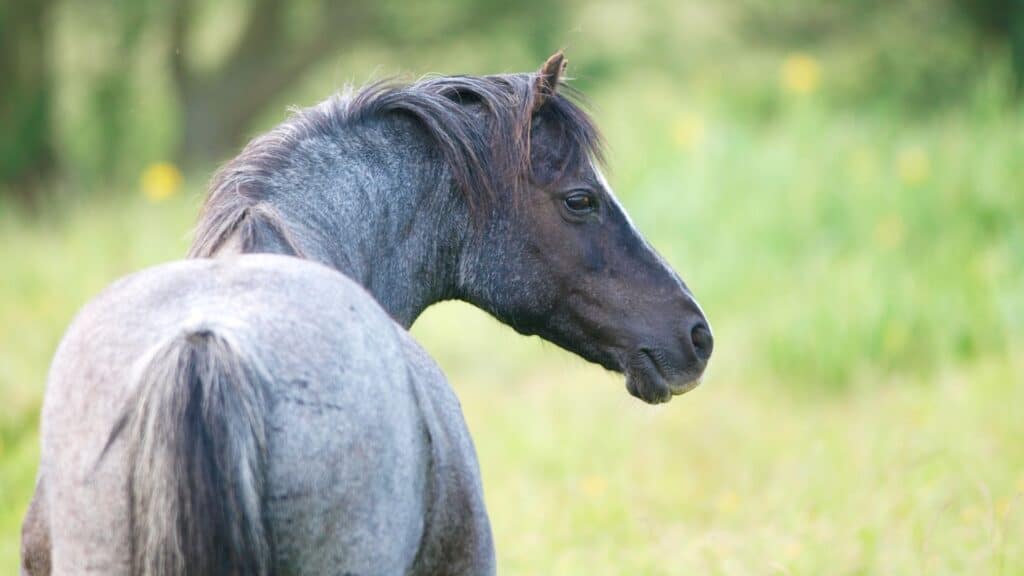
Wild Mustangs sometimes display blue roan coloring, a testament to their incredible genetic diversity and hardy nature. Encountering a blue roan Mustang in the wild is a truly special experience. Explore more in our Mustang Guide.
Percheron
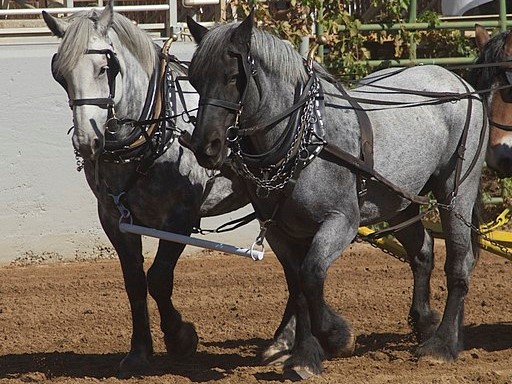
Percherons, known for their strength and gentle temperament, occasionally exhibit blue roan coats, blending power with elegance. For more on draft breeds, visit Oklahoma State University Animal Science.
Appaloosa

Appaloosas are famous for their spotted coats, and when combined with a blue roan base, the result is a striking contrast of colors. I’ve seen blue roan Appaloosas in person, and their unique patterns make them stand out in any setting.
Shire

Shire horses, another draft breed known for their immense size, occasionally boast blue roan coats, adding elegance to their powerful stature. For more on draft breeds, visit Oklahoma State University Animal Science.
Paso Fino
The Paso Fino, famous for its smooth, four-beat gait, can also be found in blue roan coloration, adding an intriguing visual dimension to a breed cherished for its comfortable ride and spirited presence.
Gypsy Vanner
Known for their stunning feathering, abundant manes and tails, and gentle disposition, Gypsy Vanners can also carry the blue roan gene. A blue roan Gypsy Vanner is a truly breathtaking sight, combining the unique coat with the breed’s opulent features.
Welsh Cob

The Welsh Cob, a versatile and hardy pony breed known for its robust build and spirited nature, can also be found in blue roan, adding a beautiful and somewhat unexpected coat color to a breed valued for its athleticism and endurance.
How to Identify a Blue Roan Horse
Identifying a true blue roan horse requires a keen eye, as their unique coat can sometimes be confused with other colors, especially by those unfamiliar with equine genetics. Understanding their key characteristics and how they differ from similar coat patterns is essential for accurate identification.
Distinguishing Features of a Blue Roan
A blue roan’s coat is a masterclass in genetic artistry, defined by several hallmark traits:
- Dark Face and Lower Legs: The most striking characteristic is the stark contrast between the roaned body and the solid, darker coloration of the head, mane, tail, and lower legs. The head typically appears black or very dark, creating a clear “mask” effect.
- Evenly Interspersed White Hairs (The Roaning Pattern): The body of a blue roan exhibits a consistent and even mixture of black and white hairs. This “salt-and-pepper” or “frosted” appearance is what gives the horse its distinctive bluish-gray optical effect. The distribution of white hairs is typically uniform across the torso, neck, and flanks.
- Mane and Tail Contrast: The mane and tail of a blue roan typically remain solid black, providing a dramatic contrast against the lighter, roaned body. This is a key differentiator from colors that lighten uniformly.
Developmental and Seasonal Changes
A blue roan’s coat is not static; it evolves slightly with age and season, but always retains its core roan identity:
- Appearance at Birth (Foals): Blue roan foals are born with their roan pattern already visible, although it may be subtle. They do not lighten significantly over time like gray foals. Their dark points (head, legs) are typically present from birth.
- Adult Coat and Seasonal Variations: While the roan pattern is permanent, the intensity of the bluish-gray hue can change seasonally. Many blue roans appear darker in their winter coat (with more black pigment) and lighter in their summer coat (with more white hairs visible), but the roaning pattern itself remains consistent.
Avoiding Common Misidentifications
To confidently identify a blue roan, it’s crucial to distinguish it from frequently confused colors:
- Vs. Gray Horses: This is the most common confusion. Gray horses are born a solid color (e.g., black, bay, chestnut) and progressively lighten with age, eventually turning completely white or dappled gray. Their heads often lighten at the same rate as their bodies, unlike the consistent dark head of a blue roan. A gray horse’s coat color results from the graying gene (G), which causes a gradual loss of pigment, not an intermixture of white hairs. Unlike blue roans, grays will continue to lighten throughout their lives.
- Vs. Grullo (and Blue Dun): Grullo horses are a diluted black. They have a smoky or mouse-gray body color but do not have white hairs interspersed throughout their coat. Key identifiers for grullo are their primitive markings, such as a prominent dorsal stripe down their back, leg barring, and often a darker mane and tail. “Blue dun” is sometimes used interchangeably with grullo, but neither possesses the roan pattern.
- Vs. White Markings/Patterns: Do not confuse blue roan with other patterns that involve white hair, such as Appaloosa roan (which can look similar but usually has distinct mottled skin and striped hooves), or sabino patterns (which create patchy, irregular white markings rather than an even mix).
If you’re ever unsure, look for these distinguishing features to tell them apart. To learn more about these coat patterns, visit the UC Davis Veterinary Genetics Laboratory.
Side-by-Side Comparison
To solidify your understanding, observe the distinct features of blue roans compared to other similar colors.


How to Care for Your Blue Roan Horse
Blue roan horses don’t need specialized care due to their coat, but targeted grooming, nutrition, and protection can enhance their stunning roan pattern and health. Follow these tips to keep your blue roan at its best.
Grooming Tips to Highlight the Roan Color
Elevate your blue roan’s bluish-gray coat with these steps:
- Enhance the Shine: Brush daily with a soft-bristled brush to spread oils and boost sheen, focusing on roaned areas to remove dirt.
- Seasonal Grooming: During spring shedding, regular brushing clears loose hair, revealing the coat’s luster and roan contrast.
- Bathing for Contrast: Use dark-coat shampoos occasionally to maintain black head, legs, mane, and tail. Spot-clean lighter patches to prevent stains.
See our Horse Grooming Guide for more.

Health Tips for Maintaining a Blue Roan’s Shine
Protect and nourish your blue roan for a thriving coat:
- Sun Protection for Dark Areas: The dark head and legs risk sunburn. Apply equine-safe sunscreen or moisturizer during long sun exposure, and use UV-blocking fly masks or sheets.
- Fly and UV Protection: Use UV-protective fly sheets and pair with citronella repellents, as noted in our Horsefly Control Strategies.
- Nutrition for Coat Health: Feed omega-3s (e.g., flaxseed), copper, and zinc for a glossy coat. Explore our Horse Coat Nutrition Guide.
Witness proper care in action:
Quick Reference
Download the Blue Roan Horse Owner’s Checklist (PDF) for care tips.
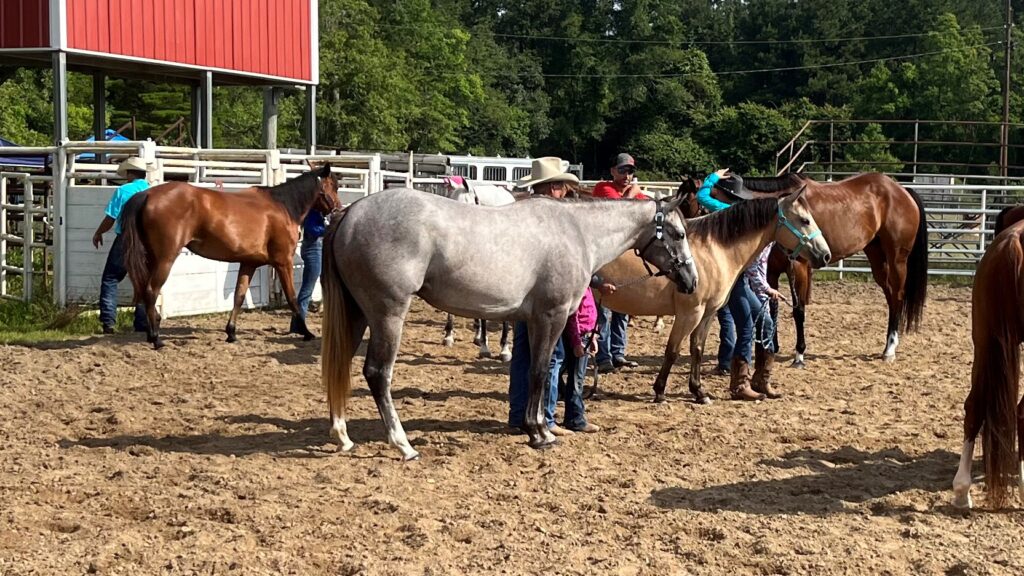
Myths & Misconceptions About Blue Roans
Blue roan horses, with their striking look, often spark curiosity and misunderstandings. Let’s separate fact from fiction to help you truly appreciate these magnificent animals.
Myth 1: Are Blue Roans More Aggressive?
Some believe blue roans are more aggressive, tying their bold appearance to “wild” stereotypes.
- Fact: Temperament depends on breeding, training, and personality—not coat color. There’s no evidence linking the roan gene (Rn) to behavior, as confirmed by studies like those from UC Davis. A blue roan Quarter Horse can be as gentle as any other with proper training.
Myth 2: Do Blue Roans Change Color with Age?
Many confuse blue roans with grays, assuming they lighten over time.
- Fact: Blue roans are born with their roan pattern, which stays consistent throughout life, unlike grays that whiten due to the graying gene (G). The mix of black and white hairs may look slightly darker in winter or lighter in summer, but blue roans don’t fully change color with age.
Myth 3: Are Blue Roans Rare?
Their unique look often makes people think blue roans are rare.
- Fact: Rarity varies by breed. The roan gene (Rn) requires a black base coat for the blue roan effect, and its frequency differs across breeds. In American Quarter Horses, the AQHA reported in 2006 that only 2.27% were blue roan, making them uncommon in that breed. In breeds like Appaloosas, competing patterns reduce their prevalence, while wild Mustangs may show more due to genetic diversity. Blue roans are sought after but not exceptionally rare overall.
For more on coat color genetics, see our Horse Coat Color Genetics Guide.

Famous Blue Roan Horses in Culture and History
Blue roan horses have left a lasting legacy through their achievements and cultural significance, their striking coats inspiring admiration across history, from the frontier to modern media. Here are two iconic blue roans and their impact.
Blue Valentine: Rodeo Legend and Western Icon
Blue Valentine, born in 1956, was a blue roan American Quarter Horse stallion renowned for his prowess in rodeo events like roping and cutting, as well as ranch work. He was often called “Blue” by his owners, the Haverty, Hayes, and Merritt families, who hauled him to compete at rodeos like Cheyenne Frontier Days, where he was noted as the “nicest horse” present. In 1968, he placed third in barrel racing at the Casper Wyoming Pro Rodeo despite never having seen a barrel before, showcasing his versatility.
His athleticism and intelligence made him a prolific sire, with his offspring continuing to shape working horse lines. In the American West of the late 1800s, blue roans like Blue Valentine were prized by cowboys for cattle drives, their unique coloring making them stand out on the range. His legacy is preserved by the Blue Valentine Headquarters, celebrating his impact on ranching culture. Learn more about his story at Saddle Up Colorado.
Royal Blue Boon: Cutting Star with Cultural Appeal
Royal Blue Boon, born in 1980, was a blue roan Quarter Horse mare who became the all-time leading dam in cutting, with progeny earnings exceeding $2.6 million as reported by Quarter Horse News in 2013. Ridden by NCHA Hall of Famer Larry Reeder, she earned $381,764 in her career, with highlights including placing eighth at the 1983 NCHA Futurity and tying for second in the 1984 NCHA Super Stakes Derby Open, earning $111,371 for that event alone.
Her foals, like Peptoboonsmal and Bet Yer Blue Boons, continued her legacy in cutting arenas. Beyond the arena, blue roans held cultural significance—Native American tribes often viewed them as symbols of mystery and resilience, featuring them in stories and art, a reverence that echoes in Royal Blue Boon’s enduring fame among cutting enthusiasts. Read more about her impact at Quarter Horse News.
Blue Roans in Media and Modern Appeal
Blue roans have also galloped into popular media. In the 1998 film The Horse Whisperer featured a blue roan as the central equine character, inspiring a new generation of fans. Breyer, the renowned model horse company, has released several blue roan figures, cementing their status as collector favorites. Today, blue roans continue to captivate audiences on social media platforms like Instagram and TikTok, where their striking coats often make them viral stars, showcasing their timeless appeal in the digital age.
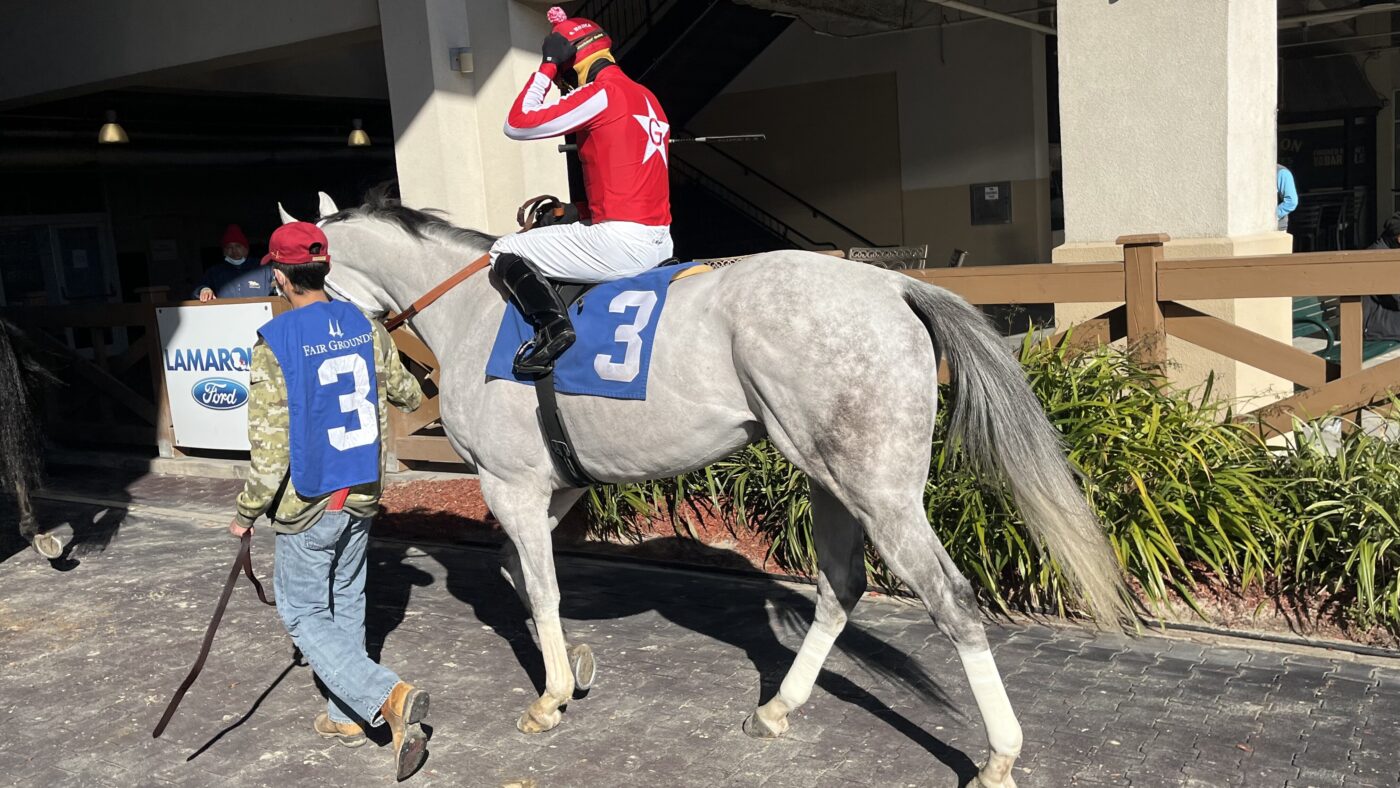
Frequently Asked Questions About Blue Roan Horses
If you’ve still got questions about blue roan horses, you’re not alone! Here are the answers to the most common ones I hear from readers and fellow horse owners.
Can two blue roans produce a healthy foal?
Yes, but genetic testing is recommended. Some breeds risk developmental issues with homozygous roan pairings. For more, see University of Kentucky’s genetics FAQ.
Do blue roans require special care?
Not specifically, but their lighter patches may need extra sun protection and grooming.
How can I confirm my horse is a true blue roan?
DNA testing through a university genetics lab can verify the presence of the roan gene. Start with UC Davis Veterinary Genetics Laboratory.
Are blue roan horses more expensive?
Their rarity and popularity can increase their price, especially in breeds like Quarter Horses.
What’s the difference between blue roan and grullo?
Grullo is a dun-based color with black points and a smoky body, while blue roan is a black base with interspersed white hairs.
Are blue roan horses good for beginners?
Blue roan horses can be excellent for beginners if they have a calm temperament and proper training. The color itself does not affect the horse’s suitability for new riders-focus on the horse’s personality, age, and experience when choosing a beginner-friendly mount.
What disciplines are blue roans best suited for?
Blue roans excel in a variety of disciplines, including ranch work, trail riding, Western pleasure, rodeo events, and even English riding. Their versatility depends more on their breed and training than their color.
Are blue roans common in Thoroughbreds?
True roans are extremely rare in Thoroughbreds, unlike Quarter Horses, where they’re more common. Veterinary Genetics Laboratory at UC Davis

How Much Does a Blue Roan Horse Cost?
Blue roan horses are highly sought after, often costing more due to their rarity. Prices vary widely based on several factors:
- Breed: Popular breeds like Quarter Horses and American Paint Horses command higher prices, especially if well-bred or registered.
- Age & Training: Young, untrained blue roans may start around $1,500-$3,000, while well-trained riding horses or those with show experience can range from $5,000-$10,000 or more.
- Pedigree & Performance: Horses with champion bloodlines, proven show records, or special skills (like ranch work or competitive events) increase their value.
- Market Demand: Their relative rarity, particularly in certain breeds, drives up demand and price.
Recent listings on Bayequest.com show blue roans often sell at a premium. For instance, a professionally trained blue roan Quarter Horse might be $8,000+, while an untrained one from a less popular breed could be found for under $3,000.
Prices also fluctuate by location, the horse’s health, and market conditions. When shopping, always compare listings, ask about health and registration papers, and consult a reputable trainer or breeder to find the right horse for your needs and budget.
Blue Roan Horse Name Ideas
Choosing the perfect name for your blue roan horse can be just as fun as picking out your new equine companion. Thanks to their unique blue-gray coats and striking presence, blue roans inspire names that are cool, creative, and memorable. Whether you prefer something classic, whimsical, or inspired by nature, here are some great ideas to get you started:
Popular Blue Roan Horse Names:
- Storm
- Slate
- Indigo
- Bluebell
- Steel
- Misty
- Denim
- Shadow
- Skye
- Cobalt
- Luna
- Ash
- River
- Smokey
- Twilight
- Sapphire
- Sterling
- Midnight
- Blueberry
- Frost
Feel free to mix and match or come up with your own unique twist! Many owners also like to choose names that reflect their horse’s personality, favorite activities, or even a special memory.
Have a favorite blue roan horse name?
Share it in the comments below, I’d love to hear your creative ideas!
Conclusion: The Enduring Allure of Blue Roan Horses
Blue roan horses are truly one-of-a-kind, blending a striking bluish-gray coat with a timeless allure that captivates horse lovers everywhere. Their unique roaning pattern—an even mix of black and white hairs—creates a frosted effect that sets them apart, while their solid dark head, legs, mane, and tail add dramatic contrast. Beyond their beauty, blue roans carry a rich history, from their symbolic significance in Native American culture to their starring roles in rodeo arenas and popular media like The Horse Whisperer. Whether you’re identifying their distinct traits, caring for their coat, or exploring their genetics, blue roans offer endless fascination for equine enthusiasts.
We’d love to see your blue roans! Share photos of your stunning blue roan horses in the comments below or tag us on social media—we can’t wait to celebrate their beauty with you.
Explore More Unique Colors: Curious about other roan shades? Dive into our guides on Roan Horses: Genetics, Breeds & Care or discover more unique equine colors in our Grullo Horse Colors: Breeds & Pictures, Palomino Horse: Golden Beauty & Genetics, and Rare Horse Colors Collection.
Glossary of Blue Roan Horse Terms
- Agouti Gene (A/a): A gene that controls the distribution of black pigment. When present (A), it restricts black to the points (mane, tail, lower legs); when recessive (a/a), black pigment is distributed evenly over the body. Essential for a black base in blue roans.
- Allele: One of two or more alternative forms of a gene that arise by mutation and are found at the same place on a chromosome. For example, Rn and rn are alleles of the roan gene.
- Base Coat Color: The primary genetic color of a horse (black, bay, or chestnut) before any modifying or diluting genes are applied.
- Corn Marks: Small patches of solid color on a roan horse’s body where the white hairs are absent, often due to injury, scar tissue, or congenital variations.
- Dilution Gene: A gene that lightens the base coat color, such as the cream gene (Cr) or dun gene (D).
- Dorsal Stripe: A darker stripe of hair running down the center of a horse’s back, often seen on dun or grullo horses.
- Eumelanin: The black/brown pigment responsible for black and bay coat colors in horses.
- Extension Locus (E/e): The genetic location that determines whether a horse can produce black pigment (eumelanin). E allows black, e restricts it to red.
- Grullo (or Blue Dun): A diluted black horse (black base + dun gene) characterized by a smoky, mouse-gray body, black points, and often primitive markings. Distinct from blue roan.
- Heterozygous (Rn/rn): Having two different alleles for a particular gene. A heterozygous roan horse has one roan allele and one non-roan allele.
- Homozygous (Rn/Rn): Having two identical alleles for a particular gene. A homozygous roan horse has two roan alleles and will always pass on the roan gene.
- Primitive Markings: Ancestral traits like dorsal stripes, leg barring (zebra stripes on legs), and shoulder stripes, typically seen on dun horses.
- Roan Gene (Rn): A dominant gene that causes an even intermixture of white hairs throughout the body coat, leaving the head, lower legs, mane, and tail solid.
- Sabino: A pinto pattern characterized by white markings on the legs and face, often with roaning on the flanks and belly, and sometimes a ragged or “lacy” edge to the white. Not a true roan.
- Strawberry Roan: A chestnut-based horse with the roan gene, resulting in an intermixture of red and white hairs, giving a pinkish or reddish appearance.
- Tobiano: A pinto pattern characterized by white patches that cross the topline between the ears and tail, typically with smooth edges and all four legs often white.
- Overo: A pinto pattern characterized by white patches that generally do not cross the topline, often with jagged edges, and usually at least one dark leg.
Further Reading & Resources
To deepen your understanding of blue roan horses and equine genetics, explore these authoritative resources referenced in this article, along with other helpful guides from Horse Racing Sense:
External Resources:
- UK Equine Genetics: Equine Coat Color Genetics 101 – University of Kentucky
- American Quarter Horse Association (AQHA) Official Site – Data on Quarter Horse registrations.
- UTIA Tennessee: Horse Coat Color Genetics (PDF) – University of Tennessee Institute of Agriculture.
- UC Davis Veterinary Genetics Laboratory: Roan Gene Test – Information on roan gene inheritance.
- PMC NCBI: Genetic Basis of Equine Coat Color Patterns – Scientific article on roan genetics.
- Oklahoma State University Animal Science: Horse Breeds – Information on various horse breeds.
More from Horse Racing Sense:
- Horse Coat Colors: 12 Patterns & Pictures – A comprehensive guide to horse coat colors.
- Equine Genetics Color Guide – Delve deeper into the science of horse coat color inheritance.
- Quarter Horse Breed Guide – Detailed profile of the American Quarter Horse.
- Paint Horse Guide – Discover the unique colors and patterns of the American Paint Horse.
- Mustang Guide – Learn about the wild American Mustang.
- Appaloosa Horse Breed Profile – Explore the spotted coats of Appaloosas.
- Gypsy Vanner (Irish Cob) Horses: Colors & Characteristics – Learn about this feathered breed.

About the Author: Miles Henry
Lifelong Horseman | Racehorse Owner | Published Author
Miles Henry brings over 25 years of hands-on experience training and owning Thoroughbred racehorses. Raised with Quarter Horses and Appaloosas, he’s spent a lifetime learning from horses—on the track, in the barn, and in the field. Today, he runs a small but successful racing stable in Louisiana and shares real-world insights on HorseRacingSense.com, helping horse owners, fans, and bettors navigate the sport with confidence.
📚 Books: View Miles’s books on Amazon »
🎧 Podcast Guest: Animal Tales Ep. 32 |
YouTube Interview
📩 Newsletter: Sign up for racing tips and horse care advice »
🔗 Follow Miles:
Twitter |
Facebook |
YouTube


